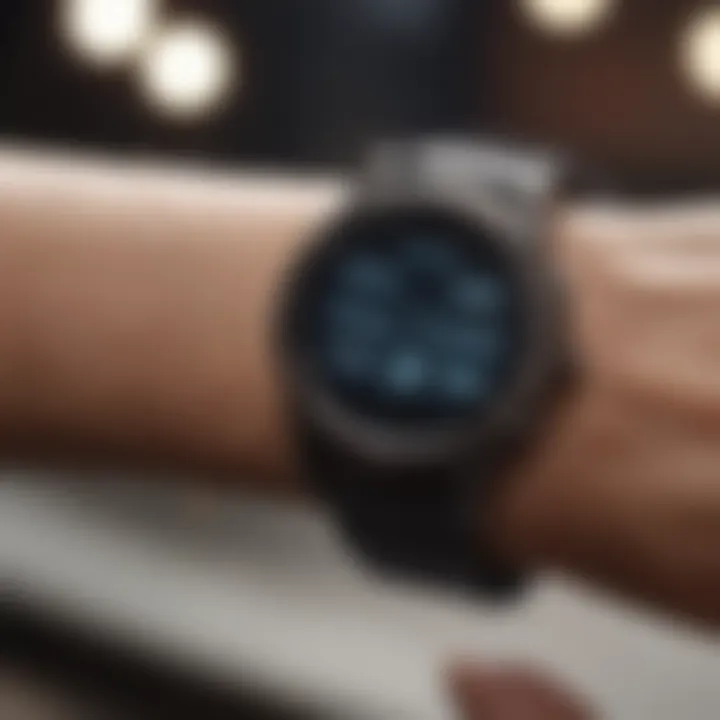Evaluating Smart Watches for Accurate Calorie Tracking


Intro
In this article, we will explore these dimensions in detail. By focusing on both the benefits and practical applications, we aim to provide readers with a nuanced understanding of how smart watches can be integrated into their health routines, while also examining the technology's trajectory and future developments.
Key Benefits
The prominent advantage of using smart watches for calorie counting lies in their integration of diverse health metrics. Users often notice not only improvements in physical health but also enhancements in mental well-being.
Physical Health Benefits
- Enhanced Accuracy: Many smart watches leverage heart rate monitoring and activity sensors to provide more precise calorie estimates compared to traditional methods.
- Real-Time Feedback: Instant notifications guide users during workouts, helping them manage their efforts effectively to maximize calorie burn.
- Comprehensive Tracking: These devices can also monitor sleep patterns and stress levels, adding another layer of insight into how lifestyle choices affect caloric expenditure.
These features contribute to informed health decisions and foster accountability, making it easier to adhere to one's fitness regimen.
Mental Well-being Enhancements
Monitoring health metrics can foster a greater sense of control. By providing intuitive access to progress, smart watches can diminish the stress often associated with weight management.
- Improved Motivation: Tracking progress visually can encourage individuals to achieve their set goals, promoting a positive feedback loop.
- Mindfulness Integration: Some smart watches offer mindfulness features, allowing users to include mental health in their wellness journey by focusing on both physical activity and mental clarity.
Practical Tips
In order to enhance the experience of calorie counting through smart watches, certain practical applications should be considered.
Effective Meal Planning
- Use Food Logging Apps: Pairing your smart watch with a reliable food logging application can streamline calorie counting. Apps like MyFitnessPal or Lose It! provide comprehensive databases to track nutritional intake.
- Portion Control: Understanding serving sizes and adjusting them based on your activity level can assist with accuracy in meals consumed.
Quick and Efficient Workouts
Exercise routines can be optimized through the features of smart watches. Utilization of specific functions can lead to better workout results.
- Set Caloric Goals: Before beginning a workout, set a specific caloric goal to aim for throughout the session. This can help in maintaining focus and drive.
- Follow Targeted Workouts: Many smart watches come with preloaded workout modes that optimize calorie usage based on settings you choose, such as running, cycling, or cardio.
"Harnessing a smart watch's features effectively can lead to notable improvements in one's health regimen."
Ultimately, understanding the benefits and practical tips associated with utilizing smart watches for calorie counting plays a crucial role in leveraging technology for health management. In the following sections, we will delve deeper into the features and limitations of current smart watch technology as well as future developments on the horizon.
Prelude to Smart Watches
Smart watches have evolved significantly over the years, moving from simple timekeeping devices to advanced health and fitness tools. Their role in monitoring health metrics, especially calorie counting, is becoming increasingly vital. Users are more conscious of their health than ever, often seeking ways to manage caloric intake and maintain their fitness goals. Smart watches offer features that can provide users with insights into their caloric expenditure, lifestyle activities, and overall wellness. Understanding their evolution helps appreciate the advantages these devices bring in calorie tracking.
Definition and Evolution of Smart Watches
The term "smart watch" refers to a wearable device that incorporates advanced computing capabilities. Initially, these watches offered basic functionalities like notifications for calls and messages. However, with advancements in technology, brands like Apple, Fitbit, and Garmin have integrated features that monitor heart rate, activity levels, and even sleep patterns.
Since their inception, smart watches have seen rapid developments. Early models focused primarily on being a stylish accessory with minimal health tracking capabilities. Nowadays, the technology integrates sensors that can measure a variety of health metrics. This evolution showcases a shift not just in form, but in function as well. Today’s smart watches resemble miniaturized fitness trackers packed with sophisticated software.
Current Market Landscape
The current market for smart watches is robust and diverse. Various brands compete by offering unique features tailored to different user needs. For instance, Apple Watch is known for its seamless integration with the Apple ecosystem, while Fitbit focuses on user-friendly health tracking. Garmin targets outdoor enthusiasts with GPS functionality and advanced metrics.
The competition in this area prompts continual innovation. Users can find models that fit their lifestyle, whether it’s an emphasis on fitness, flexibility, or style. The growing interest in personal health has driven not only sales but also investment in technology that enhances accuracy in features like calorie counting.
More recently, smart watches have begun incorporating artificial intelligence to provide personalized recommendations, making them smarter than ever before. By leveraging software algorithms that analyze user behavior, they can adjust goals based on performance, enhancing the value of caloric management.
"Today’s smart watches are not just timepieces; they are powerful tools for personal health management."
Overall, the landscape is shaped by trends towards health consciousness and technology integration, making smart watches increasingly relevant as tools for calorie counting.
Calorie Counting: An Overview
Understanding calorie counting is vital in today’s health-focused world. With the rising awareness about nutrition and its correlation to overall health, effective management of caloric intake emerges as a key aspect for individuals aiming to optimize their physical health, weight management, and fitness performance. Calorie counting itself is more than a mere tally of consumed calories; it requires a strategic approach to recognize one’s dietary patterns, nutritional needs, and exercise regimens.
A balanced caloric intake not only supports weight loss or maintenance but also ensures that the body receives adequate nutrients. The implications of poor caloric management can range from obesity to metabolic disorders, as an excess or deficit in caloric consumption leads to serious health consequences. This highlights the necessity of methods that help track these values accurately.
Incorporating technology into caloric management has the potential to simplify this endeavor. Smart watches represent an integration of convenience and accuracy, offering tools that enhance awareness about one’s caloric expenditures versus consumption, enabling a more informed approach to health. This article examines these tools, providing insight into functionalities that can assist users in achieving their goals through precise tracking.
Importance of Caloric Management
Caloric management is crucial for several reasons:
- Weight Control: Tracking calories aids in maintaining weight loss or avoiding weight gain by creating a caloric balance based on lifestyle and goals.
- Nutritional Awareness: It encourages individuals to be mindful about food choices, thus fostering a well-rounded diet rich in essential nutrients.
- Health Monitoring: Understanding daily caloric needs plays a part in preventing conditions linked to improper diet, such as diabetes and heart disease.
- Performance Optimization: Athletes particularly benefit from tailored caloric intake, enhancing their training efficiency and recovery rates.
"Proper management of caloric intake is a fundamental pillar of effective health and wellness strategies."
Methods of Calorie Tracking
Today, various methods exist for tracking caloric intake:
- Manual Tracking: Utilizes journals or spreadsheets, requiring users to log foods and calculate caloric values. This method can be prone to human error but offers a detailed insight into eating habits.
- Mobile Applications: Tools like MyFitnessPal and Lose It! provide users a platform to easily input food items, with extensive databases that streamlines the tracking process. The convenience of using apps can enhance user engagement.
- Smart Watches: Devices like the Apple Watch, Fitbit, and Garmin serve a dual purpose in tracking not only calories burned but also calories consumed through their companion apps. This integration can foster a comprehensive overview of personal health data.
- Wearable Fitness Trackers: These devices continuously monitor physical activity and calorie expenditure, allowing users to gauge their daily caloric burn.
By understanding various methods of calorie tracking, users can select the approach that best suits their lifestyle, ensuring that the management of calories becomes an achievable and sustainable objective.
How Smart Watches Count Calories
Smart watches have emerged as significant devices in the realm of health and fitness, particularly in the area of calorie counting. Their ability to accurately record caloric expenditure can influence users' health decisions and lifestyle choices. Understanding how these devices perform calorie counting is essential for discerning their efficacy. This section will discuss the technology and software employed by smart watches to track calories effectively.
Sensors and Technology Used
The sensors embedded in smart watches play a crucial role in calorie calculation. These devices often include multiple sensors to gather data.
- Heart Rate Monitors: One of the primary sensors used is the heart rate monitor. By continuously tracking the heart rate, watches can estimate calories burned based on the intensity of physical activity.
- Accelerometers: These sensors detect movement patterns. They measure changes in acceleration and provide information about the type of activity being performed, whether it be walking, running, or cycling. This data is essential for more accurately estimating calorie burn related to specific activities.
- Gyroscopes: Gyroscopes enable the watch to measure rotation and orientation, further enhancing activity recognition. This helps in distinguishing between different types of exercises.
- GPS Technology: For outdoor activities, GPS functionality can accurately measure distance traveled, adding another layer of precision to calorie calculations.
These sensors collectively contribute to a more rounded understanding of the wearer’s activity level, translating it into estimated caloric expenditure.
Software Algorithms in Calorie Calculation
The data collected by the sensors is processed using complex software algorithms. These algorithms calculate calorie burn not just from movement, but also by considering individual factors.
- Personal Data Input: Users usually input personal metrics, such as age, weight, height, and gender. This information is vital because it influences basal metabolic rate calculations.
- Activity Recognition Algorithms: The algorithms analyze sensor data for activity classification. For instance, walking burns fewer calories compared to running. This is taken into account by applying different metabolic equivalent values for various activities.
- Machine Learning Features: Some advanced models apply machine learning techniques to refine estimates. They can learn from the user's past activities and adjust calculations based on real-time data.
Through these algorithms, smart watches can provide users with a daily calorie count, helping them manage their dietary and fitness goals more effectively.
Understanding how smart watches track calories is crucial for users aiming to integrate these devices into their health routines.
In summary, both the sensors and software algorithms are indispensable in the process of calorie counting by smart watches. The integration of technology ensures a more precise and user-tailored experience, which can significantly impact users' health management strategies.
Evaluating Accuracy and Reliability
The assessment of accuracy and reliability in smart watches is critical for various reasons. First, these devices serve as tools for individuals aiming to monitor their caloric intake to support health objectives. Thus, ensuring the data they provide is precise is essential. When users rely on these watches to track calories burned, any discrepancies can lead to misguided dietary decisions. Accuracy in calorie counting promotes trust in the device and affects user engagement with the technology.
Moreover, recognizing the factors which contribute to the performance of these devices can inform users and health professionals alike. An accurate understanding of measurement efficacy also aids in setting realistic expectations from these gadgets. In this section, we will explore studies focused on smart watch accuracy and discuss the specific factors that influence their ability to count calories accurately.
Studies on Smart Watch Accuracy


Various studies have sought to analyze the precision of calorie counting in smart watches. For instance, research has compared the data obtained from watches like the Apple Watch, Fitbit, and Garmin against established methods such as metabolic carts and calorimetry.
One notable study published in a peer-reviewed journal suggested that some smart watches were able to estimate energy expenditure with a reasonable degree of accuracy. However, the study also noted that discrepancies existed with individual users' physical variations, such as body composition, age, and fitness levels.
It's important to mention that no single smart watch is universally accurate for all users. This highlights the need for continual research to improve the algorithms and sensors employed in future models. The effectiveness of different devices can vary significantly depending on their technical specifications and the environment in which they are used. A certain watch may perform admirably for one individual while another could see considerable variance.
In summary, while some devices demonstrate high accuracy levels, implications from the research suggest that caution should be exercised when interpreting these measurements. Each user must consider their individual context when relying on these devices for calorie counting.
Factors Influencing Calorie Counting Accuracy
Several factors play a role in the accuracy of calorie counts provided by smart watches. Understanding these factors can help users maximize the benefits of these technologies.
- Sensor Quality: The precision of sensors, particularly heart rate sensors and motion detectors, significantly influences calorie calculations. Higher quality sensors tend to yield more reliable measurements.
- User Profile: Individual characteristics, such as age, sex, weight, and physical fitness, all affect how calories are burned during activities. Smart watches utilize algorithms that often rely on user-inputted information to generate accurate data.
- Activity Type: The style of physical activity matters. Some watches may perform better in certain activities, like running or cycling, compared to weight lifting or yoga.
- Environmental Factors: External conditions, such as temperature and humidity, can also impact sensor performance. If a watch operates in a non-ideal environment, measurements may not reflect actual caloric expenditure.
- User Behavior: Engagement with the device also affects its accuracy. For example, if the watch is not worn correctly or if users forget to log activities, the calculations may become skewed.
Key Features to Consider
When evaluating smart watches for calorie counting, it is crucial to consider various features that can enhance their effectiveness and user experience. These features are not merely gimmicks; rather, they directly impact the reliability of the data provided and the overall functionality of the device in supporting health and fitness goals.
Integration with Fitness Apps
The integration of smart watches with fitness applications is one of the cornerstone features to consider. This capability allows users to sync their data with comprehensive fitness platforms, providing a larger context for calorie tracking. Popular applications such as MyFitnessPal or Strava facilitate seamless connection with smart watches like the Apple Watch or Fitbit. The benefits of this integration are multi-faceted:
- Comprehensive Data Tracking: Users can monitor not only calories burned but also food intake, steps, and other activities simultaneously.
- Personalized Recommendations: Many of these apps offer tailored advice based on user data, helping improve fitness routines and dietary choices.
- Community Engagement: Some applications feature community elements where users can share metrics, promoting motivation and support.
"Integration with fitness apps allows users to create a cohesive health and fitness ecosystem that enhances their overall engagement and accountability."
User Interface and Experience
Another fundamental aspect is the user interface and overall user experience of the smart watch. The design, layout, and ease of navigation play a significant role in how effectively users can utilize calorie counting features. Key considerations include:
- Clarity of Display: An effective watch should present data in an easily interpretable format, minimizing the time users need to analyze information. Clear graphs or summary screens can aid in quick assessments of calorie intake and burn.
- Accessibility of Functions: The ability to quickly access calorie counting features without extensive searching is vital. A well-designed interface allows users to log food or activities with minimal clicks.
- Customization Options: Many advanced smart watches offer customization features. Users can personalize metrics displayed on their watch face, ensuring they focus on the most relevant data for their health goals.
Ultimately, users should seek a smart watch that marries functionality with an intuitive user interface, enhancing the overall experience of calorie tracking. It's not just the data that matters but how easily it can be interpreted and acted upon.
Popular Smart Watches for Calorie Tracking
The market for smart watches has expanded significantly, with many devices now offering efficient calorie tracking functions. A lot of consumers seek to integrate these watches into their health routines. Understanding the specific smart watches available is important. Each brand has different features that cater to different user needs. Evaluating the popular options allows buyers to make informed decisions based on self requirements and goals.
Comparison of Major Brands
Apple Watch
Apple Watch stands out for its seamless integration with iOS devices and comprehensive fitness tracking features. The key characteristic of Apple Watch is its ability to sync with various health apps. This allows users to track calories effectively within an ecosystem they may already be using. A unique feature of the Apple Watch is the Activity rings, which provide visual feedback on movement, exercise, and standing. The advantage of this design is its motivational aspect, promoting daily activity. A disadvantage could be its price, as the latest models tend to be on the higher end of the market.
Fitbit
Fitbit is well-known for its focus on health and wellness. It offers a range of devices with various price points, making it accessible to many users. The primary characteristic of Fitbit is its user-friendly interface which appeals to beginners. A unique feature of Fitbit devices is their sleep tracking capabilities, providing users insights into their rest patterns. This feature supports overall wellness. However, some users report issues with syncing data or limited battery life depending on the model.
Garmin
Garmin targets fitness enthusiasts and athletes with more advanced biometrics and GPS functionalities. The defining characteristic of Garmin is its robust sports tracking abilities, particularly for outdoor activities. One unique feature is the VO2 max estimation, which provides users with important fitness metrics tailored to performance. The advantage of Garmin devices is their durability and focus on specific sports. Nonetheless, the interface may not be as intuitive as competitors, which might present a learning curve for new users.
User Reviews and Experiences
User feedback plays a crucial role in assessing these devices. Many customers express satisfaction with the calorie counting accuracy, noting that it often aligns with personal assessments. Positive experiences frequently highlight features like notifications, heart rate monitoring, and app integration. However, some users report challenges with battery life and initial set-up processes. It is important for potential buyers to consider their personal preferences and routines when evaluating user experiences.
"The right smart watch can transform how individuals monitor their caloric intake and overall health. Each option has strengths and weaknesses, so understanding these subtleties is essential for effective use."


Limitations of Smart Watches
The exploration of smart watches in calorie counting reveals significant limitations that cannot be overlooked. Understanding these constraints is crucial for users and professionals alike. While smart watches offer valuable features, it is essential to recognize that they are not infallible. Limitations can arise from both technical aspects and user behavior, impacting the accuracy and utility of these devices in managing caloric intake. In this section, we will address two critical areas: technical limitations and user engagement issues, each affecting how effectively smart watches can count calories.
Technical Limitations
Smart watches, despite their advanced technologies, face several technical limitations. One major aspect is the hardware used for measurement. Smart watches typically rely on accelerometers and heart rate monitors to estimate calorie expenditure. These sensors can provide a general sense of activity but may not capture all nuances of physical exertion. Factors such as body composition, age, and even gender influence calorie expenditure but may not be accounted for accurately by these devices.
Another technical issue is the reliance on algorithms for calorie calculation. Many smart watches use proprietary software to interpret sensor data. The accuracy of these algorithms can vary significantly between brands and models. For instance, Fitbit’s algorithms differ from those in the Apple Watch, leading to discrepancies in calorie counts. Moreover, when users engage in activities that are less common or outside the typical movement patterns, the accuracy can further decline.
"Calorie counting via smart watches is an estimation rather than an absolute. Users must approach its data with a critical eye."
Finally, battery life constraints can impact the frequency of data collection. A lower battery may limit the watch's ability to consistently monitor activity throughout the day, leading to incomplete data and misinterpretations of caloric intake.
User Behavior and Engagement Issues
User behavior plays a significant role in the efficacy of calorie counting through smart watches. In essence, the value of the data generated depends heavily on how users interact with their devices. Many users do not consistently input accurate information about their food intake or activity level. This lack of engagement can substantially undermine the effectiveness of calorie tracking.
Furthermore, users may not utilize the full capabilities of their smart watches. Some features designed to enhance accuracy, like heart rate monitoring during various exercise types, may be overlooked or improperly used, diminishing the potential benefits. For example, during high-intensity workouts, wrist-based heart rate measurements can be less reliable due to motion artifacts.
Another important consideration is user motivation. People often wear smart watches to improve their fitness; however, if motivation wanes, so can the accurate tracking of data. Inconsistent usage diminishes the value that smart watches can provide, leading to unreliable caloric estimates.
In summary, understanding the limitations of smart watches in calorie counting is essential for both practitioners and users in the health domain. Technical drawbacks may hinder accuracy, while user engagement can amplify these issues. As the technology progresses, awareness of these limitations can foster a more adept approach to leveraging smart watches in caloric management.
Future Trends in Wearable Technology
The wearable technology market is continually evolving. Currently, smart watches serve as vital instruments in health tracking, particularly in calorie counting. The future trends in this domain aim to refine these devices further, enabling them to provide greater accuracy, more comprehensive data, and ultimately better support for users’ health goals. Understanding these trends is crucial for health professionals, wellness coaches, nutritionists, fitness trainers, and mindfulness instructors who seek to integrate smart watches into their methodologies effectively.
Advancements in Measurement Technologies
The accuracy of calorie counting in smart watches is largely dependent on the measurement technologies employed. In the coming years, advancements such as improved heart rate monitoring, blood oxygen levels tracking, and even sweat analysis will emerge. Sensors will likely evolve to include more sophisticated biometric capabilities while miniaturizing technology, making it user-friendly. These advances promise to enhance the precision of calorie expenditure calculations significantly.
For instance, sensors like accelerometers will become more sensitive and capable of capturing even minor movements. Furthermore, integration of machine learning with these devices will allow them to adapt to individual users, refining their calorie estimation over time based on personal activity patterns.
"The technology behind smart watches is progressing at an unprecedented rate, and with it, the potential for accurate health monitoring expands."
Integration with Health Monitoring Systems
Another significant trend is the increasing integration of smart watches with health monitoring systems. By harnessing the power of cloud computing and big data, smart watches can sync with various health platforms. This network will allow users to access not only calorie data but also broader health indicators, such as sleep quality, stress levels, and dietary habits.
Such integration serves multiple purposes:
- Holistic Health Tracking: Users can see how different factors, such as stress or sleep patterns, affect their caloric needs and overall health.
- Personalized Health Insights: Data collected can drive personalized recommendations. For instance, if a user is not getting enough sleep, the smart watch might suggest adjustments to caloric intake.
- Social Sharing and Support: Features allowing users to share their progress with trainers or peers can foster motivation and accountability, optimizing results.
In summary, future advancements in wearable technology will not just focus on calorie counting; they will integrate a more comprehensive health monitoring ecosystem. As these technologies progress, they will provide users with deeper insights and actionable data to better manage their health.
Closure
The conclusion of an article serves not merely as an end but as a pivotal summation of the insights gathered throughout the discussion. In this context, the effectiveness of smart watches in calorie counting encapsulates essential observations on their strengths, weaknesses, and practical applications in health management. It is crucial for readers to acknowledge the transformative potential these devices hold. When selected and utilized correctly, smart watches can significantly contribute to better health monitoring and informed dietary choices.
Summarizing Key Insights
The exploration into smart watches reveals several key insights regarding their role in calorie counting:
- Accuracy of Measurements: Various studies underscore the strengthening accuracy of calorie counts with upcoming models. However, discrepancies persist due to external factors like user behavior.
- Features and Usability: Features such as heart rate tracking, GPS capabilities, and integration with health apps can enhance the user's ability to manage caloric intake more effectively.
- Influence on Lifestyle: Regular use of smart watches can promote a more active lifestyle as users receive real-time feedback about their activities.
In summary, while not infallible, smart watches serve as valuable tools in a broader health strategy. Their integration in daily routines affirms a commitment to personal wellness.
Recommendations for Users
For readers interested in leveraging smart watches for calorie counting, several recommendations can enhance their efficacy:
- Choose the Right Device: Not all smart watches are created equal. Evaluate brands like Apple Watch, Fitbit, and Garmin that are known for their advanced calorie tracking features.
- Use Complementary Apps: Integrate your smart watch with other fitness or dietary tracking applications to gain comprehensive insights into your health metrics.
- Set Realistic Goals: Establish achievable fitness and dietary objectives to prevent frustration with your tracking efforts.
- Stay Engaged: Consistently interact with your smart watch to make the most of its features. Regular updates and feedback can provide motivation and accountability.
- Consult Health Professionals: If uncertain about your fitness regime or dietary needs, it is wise to consult a nutritionist or health coach for personalized advice.
The thoughtful integration of smart watches into health and fitness routines can offer substantial benefits. However, informed choices and realistic expectations will play a vital role in maximizing their potential.















